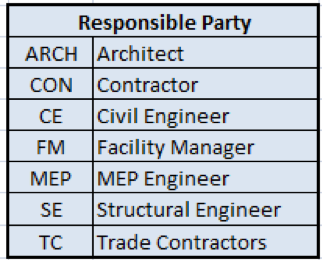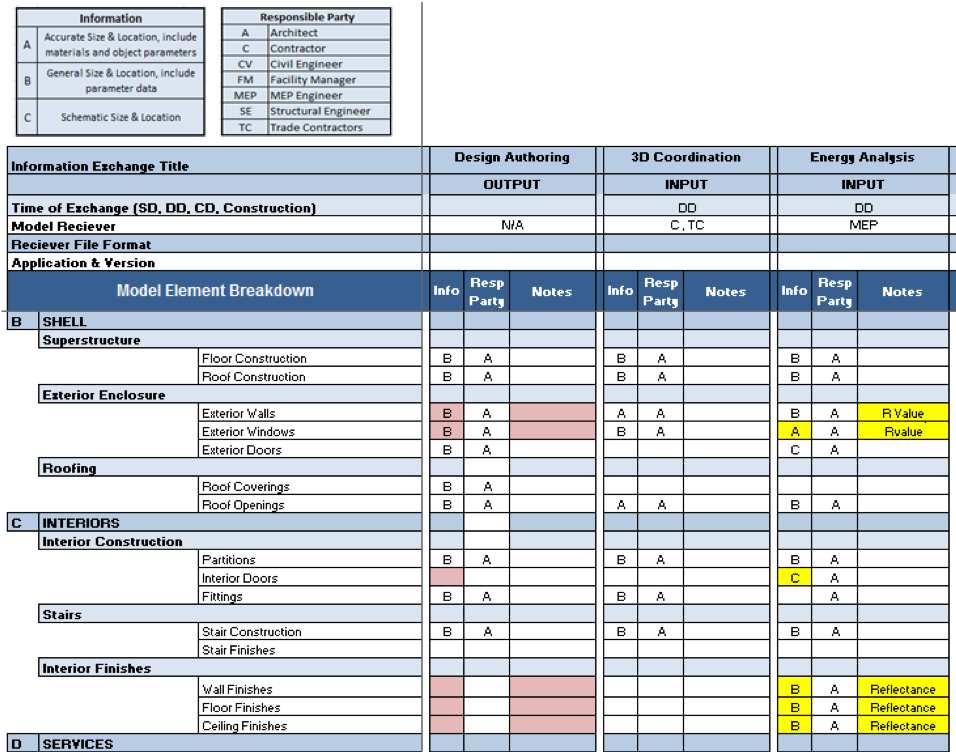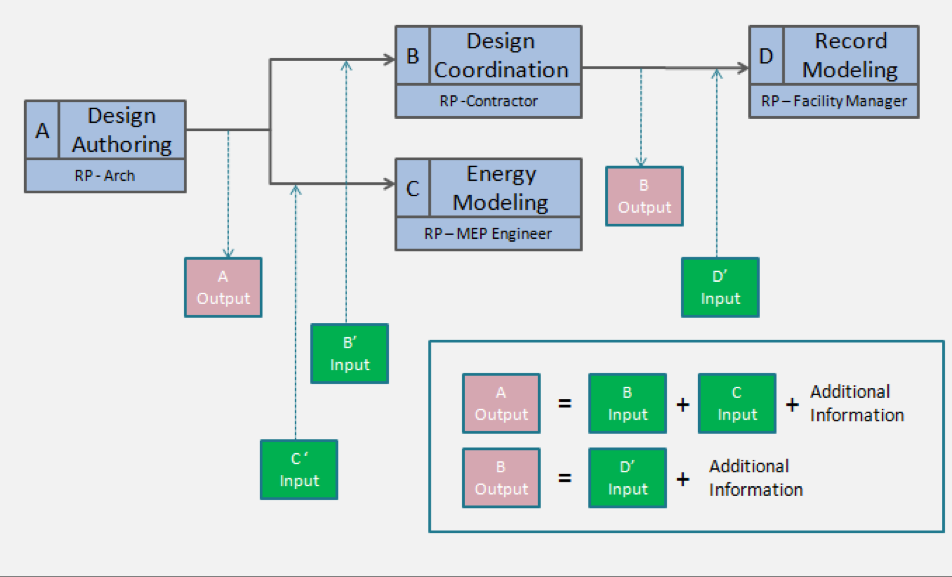4 Developing Information Exchanges
The goal of this chapter is to present a method for defining information exchanges (identified in Chapter Three) between project processes that are crucial to successful BIM implementation. To define these exchanges, the team needs to understand what information is necessary to deliver each BIM Use. To assist in this task, an Information Exchange (IE) Worksheet was designed. The Information Exchange Worksheet should be completed in the early stages of a project after designing and mapping the BIM process. A blank graphical version of the IE Worksheet is available in Appendix F and a Microsoft Excel version is available at Template – Information Exchange Worksheet V2-1 – MS Excel Format. The procedure for filling out the worksheet is described in Section Two of this chapter.
1. Pulling the Information Through the Project
Every element of a project does not need to be included in a model to achieve value from the modeling process. Therefore, it is important to only define the model components that are necessary to implement each BIM Use. Figure 4-1 depicts an example of how information flows through a BIM implementation process.
This figure was derived from the Level One process map described in Chapter Three. Note that downstream BIM Uses are directly affected by what is produced by the upstream Use. Looking at this example from the perspective of a pull-driven approach, if the model information required to implement a particular BIM Use is not authored by an upstream team member, then the information needed must be created by the responsible party of that Use. Therefore, it is up to the project team to decide who should be authoring this information and when this information needs to be placed into the BIM. For simplicity purposes, it is only necessary that the team define one information exchange requirement for each BIM Use; although, there may be several exchanges that take place. These exchanges should be clarified in the Level Two process maps depicted in Chapter Three.
Information Exchange Worksheet
After process map development, information exchanges between project participants should be clearly identified. It is important for the team members and, in particular, the author and receiver of each information exchange transaction to clearly understand the information content. The procedure for creating the information exchange requirements is detailed below. It is important to note that there are several other standards or requirements that you can use to develop the information exchange definitions depending upon the project requirements, contracts or preferences of the team. One option is to perform a similar process as below, but use the BIMForum Level of Development spreadsheet to define each of the exchanges. Another option is to use the US Army Corps of Engineers Minimum Modeling Matrix (M3). While these tools vary in format and detail from the procedure below, they can all be used to define the level of development for each model exchanged within the process.
1) Identify each potential information exchange from the Level 1 Process Map
Information Exchanges that are shared between two parties should be defined. One BIM Use may have multiple exchanges; however, to simplify the process, only one exchange is necessary to document each Use. Also, the time of exchange should be derived from the Level One Map. This ensures that the involved parties know when the BIM deliverables are expected to be completed along with the project’s schedule. The project phases should also be identified in the project-specific contract language (Chapter Five). When possible, the BIM Use exchanges should be listed in chronological order to give a visual representation of the progression of the model requirement.
2) Choose a Model Element Breakdown structure for the project
After the project team has established the Information Exchanges (IE), the team should select an element breakdown structure for the project. Currently, the IE Worksheet uses the CSI Uniformat II structure; however other options are available on the BIM Execution project website.
3) Identify the Information Requirements for each Exchange (Output & Input)
To define each information exchange, the following information should be documented:
a. Model Receiver – Identify all project team members that will be receiving the information to perform a future BIM Use. These parties are responsible for filling out the Input Exchanges. Output exchanges will not have a model receiver and should be filled out by the project team, initiated by the Architect.
b. Model File Type – List the specific software application(s), as well as, the version that will be used to manipulate the model during each BIM Use by the receiver. This is pertinent in order to identify any interoperability that may exist between exchanges.
c. Information – Identify only the information necessary for the BIM Use implementation. Currently, the IE Worksheet uses a three-tier level of detail structure, shown in Table 4-1.
Table 4.1: Information Level of Detail

d. Notes – Not all necessary requirements for model content may be covered by the information and element breakdown structure, and if more description is needed, it should be added as a note. Notes can be specific to certain modeling content and/or depict a modeling technique.
4) Assign Responsible Parties to Author the Information Required
Each line item in an Information Exchange should have a party who is responsible for authoring the information. The responsibility for creating the information should lie with the party that can produce with the highest level of efficiency. Additionally, the time of input should be when it is needed by the model receiver, based on the level 1 process map. The worksheet can be sorted according to the responsible party to determine ones scope for each BIM deliverable. Table 4-2 below is a list of potential responsible parties.
Table 4.2: List of Potential Responsible Parties

5) Compare Input versus Output Content
Once the information requirements are defined, it is necessary for the project team to discuss the specific elements where the Output information (Authored) does not match the Input information (requested). The example in Figure 4-2 depicts an inconsistency between a Design Authoring Output Model and an Energy Analysis Input Model. When this occurs, two potential remedial actions need to take place:
1. Output Information Exchange Requirement –revise the information to a higher level of accuracy and/or include additional information (e.g. add R-Value to Exterior Walls); OR
2. Input Information Exchange Requirement –revise the responsible party so that information is authored by the organization performing the BIM Use




